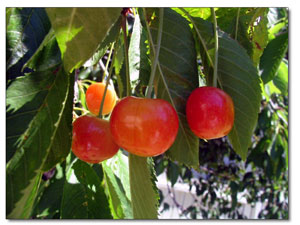|
|
The fruit is onby Ari LeVau
A crop of apricots neglected on a neighbor’s tree can often be gleaned for a knock and the polite asking. Farmers packing away their leftovers at the end of market might be ready to make a deal (such arrangements have been known to lead to offers to pick trees clean). There are feral or abandoned orchards, u-pick farms and orchards, and even grocery stores – after all, when fruit is in season it’s usually cheap, so you don’t have to fall out of a tree or get shot for trespassing just to get some. That said, the harvest is not going to come to you. Go get that fruit before the birds and bugs get it, before it ends up in the compost pile or the dumpster, and before it drops to the ground. If it does drop, pick up the good ones. I consider this generalist approach to fruit acquisition to be in the hunter/gatherer tradition. Hunter/gatherers, anthropologists believe, generally have more free time than any other societal structure, allowing for plenty of backgammon and baby-making through the ages. As part of an integrated modern lifestyle, picking a bunch of fruit probably won’t create any extra free time. In fact, it can sometimes land you a large ripe pile that you then have to invest more time in processing. That’s why when I preserve the bounty of summer, be it fruit, vegetable, berry or root, I usually choose the simplest path to quickly and efficiently stabilize the product. I’m trying to pack away as much food as I can, and I don’t often want to mess around with recipes that slow me down. I do have some specialty preparations I’ve grown to depend on over the years, like my pickled peppers, salsa, catsup, and stack of frozen plum tortes. But while I appreciate a jar of apricot chutney as much as anyone, I prefer to just put them in jars and figure it out later. For cherries and strawberries, both of which are in season now, I have two methods: freezing them whole (the easiest) and making a simple preparation I call fruit-in-jars. To freeze them whole, just clean, dry and (if applicable) pit the fruit, pack them gently in a jar or bag, with as little air inside as possible, and freeze. That’s it. They won’t last as long as a Twinkie, but up to a year with no significant deterioration. Fruit-in-jars is more involved. The process is similar to making jam, but I prefer it because it’s simpler, and more importantly because jam requires pectin, a polysaccharide usually derived from apple peel that’s available in powder form. Pectin is what thickens jam, but only if you add sugar, which makes the pectin congeal. Adding sugar to fruit is unhealthy and absurd, and since I’m not a bread person I have little use for jam. All the jam-spreaders out there, who likely comprise a majority of the general populace, should take note that there is a type of pectin, called Pomona’s Pectin, that’s designed for low-sugar or no-sugar jam. The recipes that come with it call for juice, like apple or pineapple, in place of sugar. That’s all I’m going to say about jam, because I skip the sugar, juice and pectin entirely. I simply cook the cleaned, pitted and perhaps chopped fruit in a pot, preferably heavy-bottomed, in a little bit of water with the lid on. The resulting fruit-in-jars can be resurrected in the dead of winter as practically anything you want, including jam. I leave the cherries and strawberries whole. The sauce between fruit chunks thickens as it cooks. Add water as necessary to keep the fruit covered. The longer you cook it, the thicker the resulting mush will be. If I’m doing this with apricots, and sometimes peaches, I let the fruit cool after it’s been cooked down, and then puree it in a blender or food processor into a thick juice before canning. Fruit-in-jars can be frozen or canned. If you have the freezer space, your best bet is to freeze the jars, filled ¾ full to allow for expansion. That’s the quickest, easiest option. And since freezers work harder when they’re not full, you’re saving both energy and your freezer’s life by taking this easy-freezy route. This is especially applicable in early summer, when freezers tend to be at their emptiest. If you don’t have freezer space, canning the fruit is your best option. Low-acid fruits like apples, pears and plums will need to be pressure-canned, while the tarter fruits can hold off spoilage with their acid content, and only need a simple water-bath. Cherries need to water-bath for 25 minutes, (longer at high elevations). Strawberries, along with apricots, which are coming on as we speak, are higher in acid and need only 20 minutes. To properly handle all of the fruit that’s coming, you need a trusted source that gives the proper processing times and techniques for each fruit and tells you which ones need pressure, and how much. This information is out there in many forms. A county or university extension service is a good source of information on processing fruit in your area. The book Stocking Up by Rodale Press has this information. Online, the National Center for Home Food Preservation (http://nchfp.uga.edu/) has canning times for fruit at every elevation. Experiment with different preparations. Figure out which storage forms you and your family prefer. Each year you’ll get better, and more efficient, at squirreling away the fruits of summer in a way that still allows for some good old fashioned hunter/gatherer leisure. |


